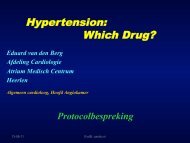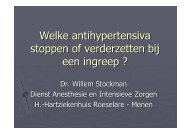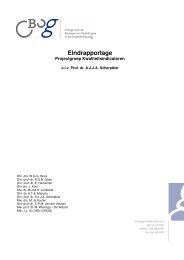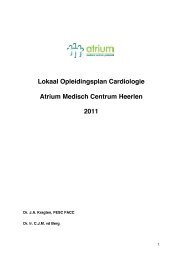46 ESC <str<strong>on</strong>g>Guidelines</str<strong>on</strong>g>was addressed in a Report from <strong>the</strong> ESC Joint Study Group <strong>on</strong><strong>the</strong> Treatment <strong>of</strong> Refractory <strong>Angina</strong>, published in 2002. 660Chr<strong>on</strong>ic stable refractory angina can be defined as a clinicaldiagnosis based <strong>on</strong> <strong>the</strong> presence <strong>of</strong> symptoms <strong>of</strong> stableangina, thought to be caused by ischaemia due to advancedcor<strong>on</strong>ary disease and which are not c<strong>on</strong>trollable by a combinati<strong>on</strong><strong>of</strong> maximal medical <strong>the</strong>rapy, bypass surgery and percutaneousinterventi<strong>on</strong>. N<strong>on</strong>-cardiac causes <strong>of</strong> chest painshould be excluded, and where appropriate, cognitive behavioural<strong>the</strong>rapy, psychological assessment, and/or psychiatricc<strong>on</strong>sultati<strong>on</strong> may be c<strong>on</strong>sidered.According to <strong>the</strong> previously menti<strong>on</strong>ed report from <strong>the</strong>Joint Study Group, we have no accurate figures <strong>on</strong> <strong>the</strong>occurrence and frequency <strong>of</strong> refractory angina. A Swedishsurvey <strong>of</strong> patients referred for cor<strong>on</strong>ary arteriographybecause <strong>of</strong> stable angina pectoris performed in 1994–95showed that nearly 10% <strong>of</strong> patients were rejected for revascularizati<strong>on</strong>despite severe symptoms. 661,662The most comm<strong>on</strong> reas<strong>on</strong>s that revascularizati<strong>on</strong> is notc<strong>on</strong>sidered appropriate are:(1) Unsuitable anatomy(2) One or several previous bypass grafting and/or PTCAprocedures(3) Lack <strong>of</strong> available graft c<strong>on</strong>duits(4) Extra-cardiac diseases which increase perioperativemorbidity and mortality(5) Advanced age, <strong>of</strong>ten in combinati<strong>on</strong> with <strong>the</strong>se factorsChr<strong>on</strong>ic refractory angina requires an effective optimizati<strong>on</strong><strong>of</strong> medical treatment assuring <strong>the</strong> use <strong>of</strong> differentdrugs in maximal tolerated doses. This issue is extensivelydeveloped in <strong>the</strong> original document <strong>of</strong> <strong>the</strong> Joint StudyGroup. Within <strong>the</strong> last few years, new modalities exploringnew c<strong>on</strong>cepts <strong>of</strong> <strong>the</strong>rapy are under extensive evaluati<strong>on</strong>,although not all have been successful: neuromodulati<strong>on</strong>techniques (transcutaneous electric nerve stimulati<strong>on</strong> andspinal cord stimulati<strong>on</strong>), thoracic epidural anaes<strong>the</strong>sia,endoscopic thoracic sympa<strong>the</strong>ctomy, stellate gangli<strong>on</strong>blockade, transmyocardial or percutaneous laser revascularizati<strong>on</strong>,angiogenesis, enhanced external counterpulsati<strong>on</strong>,heart transplantati<strong>on</strong>, and drugs that modulate metabolism.Transcutaneous electrical stimulati<strong>on</strong> and spinal cordstimulati<strong>on</strong> are well-established methods used in severalcentres for <strong>the</strong> management <strong>of</strong> refractory angina with positiveeffects <strong>on</strong> symptoms and a favourable side-effectpr<strong>of</strong>ile. 663–665 These techniques have a favourable analgesiceffect even without any improvement in myocardial ischaemia.A significant increase in <strong>the</strong> average exercise time <strong>on</strong>treadmill testing has however been observed. The number<strong>of</strong> published reports and <strong>the</strong> number <strong>of</strong> patients enrolledin clinical trials are small, and <strong>the</strong> l<strong>on</strong>g-term effects <strong>of</strong><strong>the</strong>se techniques are unknown.Enhanced external counterpulsati<strong>on</strong> (EECP) is an interestingn<strong>on</strong>-pharmacological technique, which has also beeninvestigated largely in <strong>the</strong> USA. Two multi-centre registrieshave evaluated <strong>the</strong> safety and effectiveness <strong>of</strong> EECP. 666–668The technique is very well tolerated when used over aperiod <strong>of</strong> 35 hours <strong>of</strong> active counterpulsati<strong>on</strong> during4–7-week period. <strong>Angina</strong>l symptoms were improved in75–80% <strong>of</strong> patients.Transmyocardial revascularizati<strong>on</strong> has been comparedwith medical <strong>the</strong>rapy in several studies. In <strong>on</strong>e study (in275 patients with CCS class IV symptoms), 76% <strong>of</strong> patientswho had underg<strong>on</strong>e transmyocardial revascularizati<strong>on</strong>improved two or more functi<strong>on</strong>al classes after 1 year <strong>of</strong>follow-up, as compared with 32% (P , 0.001) <strong>of</strong> <strong>the</strong> patientswho received medical <strong>the</strong>rapy al<strong>on</strong>e. 669 Mortality did notdiffer significantly between <strong>the</strong> two groups. O<strong>the</strong>r studies<strong>of</strong> transmyocardial revascularizati<strong>on</strong> (ei<strong>the</strong>r surgically or percutaneously)have been unable to c<strong>on</strong>firm this benefit. 670,671In particular, a recent randomized c<strong>on</strong>trolled trial <strong>of</strong> 298patients showed that treatment with percutaneous myocardiallaser provides no benefit bey<strong>on</strong>d that <strong>of</strong> a similar shamprocedure in patients blinded to <strong>the</strong>ir treatment. 672Fur<strong>the</strong>rmore, measurement <strong>of</strong> regi<strong>on</strong>al myocardial bloodflow and cor<strong>on</strong>ary flow reserve by means <strong>of</strong> PET has failedto show imporved perfusi<strong>on</strong> following this procedure. 673Internati<strong>on</strong>al studies and registries are urgently requiredto clarify <strong>the</strong> epidemiology <strong>of</strong> this c<strong>on</strong>diti<strong>on</strong> and fur<strong>the</strong>rresearch is encouraged to definitely establish <strong>the</strong> roles <strong>of</strong>existing and novel alternative techniques to manage <strong>the</strong>sepatients.C<strong>on</strong>clusi<strong>on</strong>s and Recommendati<strong>on</strong>s(1) <strong>Angina</strong> pectoris due to cor<strong>on</strong>ary a<strong>the</strong>rosclerosis is acomm<strong>on</strong> and disabling disorder. Although compatiblewith l<strong>on</strong>gevity, <strong>the</strong>re is an increased risk <strong>of</strong> progressi<strong>on</strong>to MI and/or death. With proper management, <strong>the</strong>symptoms can usually be c<strong>on</strong>trolled and <strong>the</strong> prognosissubstantially improved.(2) Every patient with suspected stable angina requiresprompt and appropriate cardiological investigati<strong>on</strong> toensure that <strong>the</strong> diagnosis is correct and that <strong>the</strong> prognosisis evaluated. As a minimum, each patient shouldhave a carefully taken history and physical examinati<strong>on</strong>,a comprehensive risk factor evaluati<strong>on</strong>, and aresting ECG.(3) To c<strong>on</strong>firm <strong>the</strong> diagnosis and plan fur<strong>the</strong>r management,an initial n<strong>on</strong>-invasive strategy, using exercise ECG,stress echo, or myocardial perfusi<strong>on</strong> scintigraphy ismost appropriate. This allows an assessment <strong>of</strong> <strong>the</strong>likelihood <strong>of</strong> and <strong>the</strong> severity <strong>of</strong> CHD in patients withmild-to-moderate symptoms and effective risk stratificati<strong>on</strong>.In many patients, cor<strong>on</strong>ary arteriography mayfollow, but an initial invasive strategy without priorfuncti<strong>on</strong>al testing is rarely indicated, and may <strong>on</strong>lybe c<strong>on</strong>sidered for patients with new <strong>on</strong>set severe orunc<strong>on</strong>trolled symptoms.(4) The exercise ECG should be interpreted with attenti<strong>on</strong>to haemodynamic resp<strong>on</strong>se, workload achieved, andclinical features <strong>of</strong> <strong>the</strong> individual as well as symptomsand ST-segment resp<strong>on</strong>se. Alternative investigati<strong>on</strong>sare needed when exercise is not possible or <strong>the</strong> ECG isnot interpretable, or in additi<strong>on</strong> to exercise testingwhen <strong>the</strong> diagnosis remains uncertain or functi<strong>on</strong>alassessment is inadequate.(5) In additi<strong>on</strong> to <strong>the</strong>ir role in intial assessment <strong>of</strong> stableangina symptoms, myocardial perfusi<strong>on</strong> scintigraphyand stress echocardiography are <strong>of</strong> particular value indem<strong>on</strong>strating <strong>the</strong> extent and localizati<strong>on</strong> <strong>of</strong> myocardialischaemia.(6) Echocardiography and o<strong>the</strong>r n<strong>on</strong>-invasive imaging modalities,such as magnetic res<strong>on</strong>ance, are helpful in evaluatingventricular functi<strong>on</strong>.
ESC <str<strong>on</strong>g>Guidelines</str<strong>on</strong>g> 47(7) The interpretati<strong>on</strong> <strong>of</strong> chest pain is particularly difficultin young and middle-aged women. The classicalsymptom complex <strong>of</strong> chr<strong>on</strong>ic stable angina, which is areliable indicator <strong>of</strong> obstructive cor<strong>on</strong>ary disease inmen, is not so in younger women. This problem is compoundedby <strong>the</strong> higher prevalence <strong>of</strong> cor<strong>on</strong>ary arteryspasm and ‘Syndrome X’ in women with chest painand by <strong>the</strong> frequency <strong>of</strong> ‘false-positive’ exercisetests. However, <strong>the</strong>se complexities should not preventappropriate investigati<strong>on</strong> and treatment <strong>of</strong> women,particularly <strong>the</strong> use <strong>of</strong> n<strong>on</strong>-invasive investigati<strong>on</strong>s for<strong>the</strong> purposes <strong>of</strong> risk stratificati<strong>on</strong> and use <strong>of</strong> sec<strong>on</strong>darypreventative <strong>the</strong>rapies.(8) After initial risk evaluati<strong>on</strong>, risk-factor correcti<strong>on</strong> bylife-style modificati<strong>on</strong> should be implemented inadditi<strong>on</strong> to pharmacological interventi<strong>on</strong> as necessary.Strict diabetic c<strong>on</strong>trol and weight c<strong>on</strong>trol al<strong>on</strong>gwith smoking cessati<strong>on</strong> strategies are str<strong>on</strong>gly advisedin all patients with cor<strong>on</strong>ary disease, and bloodpressure c<strong>on</strong>trol is extremely important. Successfulrisk-factor management may modify <strong>the</strong> initial riskassessment.(9) In terms <strong>of</strong> specific pharmacological <strong>the</strong>rapy, shortactingnitrates, when tolerated, may be used toprovide acute symtomatic relief. In <strong>the</strong> absence <strong>of</strong> c<strong>on</strong>traindicati<strong>on</strong>sor intolerance, patients with stableangina pectoris should be treated with aspirin(75 mg/day) and statin <strong>the</strong>rapy. A beta-blocker shouldbe used first line or, alternatively, a calcium-channelblocker or l<strong>on</strong>g-acting nitrate may be used to provideanti-anginal effects, as described earlier, withadditi<strong>on</strong>al <strong>the</strong>rapy as necessary. ACE-inhibiti<strong>on</strong> is indicatedin patients with co-existing ventricular dysfuncti<strong>on</strong>,hypertensi<strong>on</strong>, or diabetes and should be str<strong>on</strong>glyc<strong>on</strong>sidered in patients with o<strong>the</strong>r high-risk features.Beta-blockers should be recommended in all post-MIpatients and in patients with LV dysfuncti<strong>on</strong>, unlessc<strong>on</strong>traindicated.(10) Anti-anginal drug treatment should be tailored to <strong>the</strong>needs <strong>of</strong> <strong>the</strong> individual patient and should be m<strong>on</strong>itoredindividually. The dosing <strong>of</strong> <strong>on</strong>e drug should beoptimized before adding ano<strong>the</strong>r <strong>on</strong>e, and it is adviseableto switch drug combinati<strong>on</strong>s before attempting athree drug regimen.(11) If not undertaken for fur<strong>the</strong>r prognostic evaluati<strong>on</strong>,cor<strong>on</strong>ary arteriography should be undertaken whensymptoms are not satisfactorily c<strong>on</strong>trolled by medicalmeans, with a view to revascularizati<strong>on</strong>.(12) PCI is an effective treatment for stable angina pectorisand is indicated for patients with angina not satisfactorilyc<strong>on</strong>trolled by medical treatment when <strong>the</strong>reare anatomically suitable lesi<strong>on</strong>s. Restenosis c<strong>on</strong>tinuesto be a problem, which has been diminished byadvances in stenting technology. There is no evidencethat PCI reduces <strong>the</strong> risk <strong>of</strong> death in patients withstable angina compared with medical or surgical<strong>the</strong>rapy.(13) CABG is highly effective in relieving <strong>the</strong> symptoms <strong>of</strong>stable angina and reduces <strong>the</strong> risk <strong>of</strong> death over l<strong>on</strong>gtermfollow-up in particular subgroups <strong>of</strong> patients,such as those with LM stem stenosis, proximal LADstenosis, and three-vessel disease, especially if LVfuncti<strong>on</strong> is impaired.(14) There is evidence 674,675 that some gaps remainbetween best practice and usual care in <strong>the</strong> management<strong>of</strong> stable angina. Specifically, many individualswith stable angina are not referred for functi<strong>on</strong>altesting to c<strong>on</strong>firm <strong>the</strong> diagnosis and determine prognosis.Fur<strong>the</strong>rmore, <strong>the</strong>re is worrying variability in rates<strong>of</strong> prescripti<strong>on</strong> <strong>of</strong> statins and aspirin. Because <strong>of</strong> <strong>the</strong>wide variati<strong>on</strong>s in <strong>the</strong> quality <strong>of</strong> care afforded to sufferersfrom angina, <strong>the</strong>re is a str<strong>on</strong>g case for auditingseveral comp<strong>on</strong>ents <strong>of</strong> <strong>the</strong> management <strong>of</strong> <strong>the</strong> c<strong>on</strong>diti<strong>on</strong>.As is <strong>the</strong> practice in some countries, local,regi<strong>on</strong>al, or nati<strong>on</strong>al registers <strong>of</strong> <strong>the</strong> outcome <strong>of</strong> PCIand surgery should be created and maintained.References1. De Backer G, Ambrosi<strong>on</strong>i E, Borch-Johnsen K, Brot<strong>on</strong>s C, Cifkova R,Dall<strong>on</strong>geville J et al. European guidelines <strong>on</strong> cardiovascular diseasepreventi<strong>on</strong> in clinical practice: third joint task force <strong>of</strong> European ando<strong>the</strong>r societies <strong>on</strong> cardiovascular disease preventi<strong>on</strong> in clinical practice(c<strong>on</strong>stituted by representatives <strong>of</strong> eight societies and by invitedexperts). Eur J <strong>Cardio</strong>vasc Prev Rehabil 2003;10:S1–S10.2. Heberden. Some account <strong>of</strong> a disorder <strong>of</strong> <strong>the</strong> breast. Med Transact R CollPhys L<strong>on</strong>d 1772;2:59.3. Parry CH. An inquiry into <strong>the</strong> symptoms and causes <strong>of</strong> syncope anginosa,comm<strong>on</strong>ly called angina pectoris. Edinburgh, L<strong>on</strong>d<strong>on</strong>: Bryce, Murray andCallow;1799.4. Crea F, Gaspard<strong>on</strong>e A. New look to an old symptom: angina pectoris.Circulati<strong>on</strong> 1997;96:3766–3773.5. Tomai F, Crea F, Chiariello L, Gi<strong>of</strong>fre PA. Ischemic prec<strong>on</strong>diti<strong>on</strong>ing inhumans: models, mediators, and clinical relevance. Circulati<strong>on</strong>1999;100:559–563.6. Cohn PF, Fox KM, Daly C. Silent myocardial ischemia. Circulati<strong>on</strong>2003;108:1263–1277.7. Gould KL, Kirkeeide RL, Buchi M. Cor<strong>on</strong>ary flow reserve as a physiologicmeasure <strong>of</strong> stenosis severity. J Am Coll <strong>Cardio</strong>l 1990;15:459–474.8. Gould KL. Effects <strong>of</strong> cor<strong>on</strong>ary stenoses <strong>on</strong> cor<strong>on</strong>ary flow reserve andresistance. Am J <strong>Cardio</strong>l 1974;34:48–55.9. Mohlenkamp S, Hort W, Ge J, Erbel R. Update <strong>on</strong> myocardial bridging.Circulati<strong>on</strong> 2002;106:2616–2622.10. Pupita G, Maseri A, Kaski JC, Galassi AR, Gavrielides S, Davies G et al.Myocardial ischemia caused by distal cor<strong>on</strong>ary-artery c<strong>on</strong>stricti<strong>on</strong> instable angina pectoris. N Engl J Med 1990;323:514–520.11. Braunwald E. Unstable angina. A classificati<strong>on</strong>. Circulati<strong>on</strong> 1989;80:410–414.12. Myocardial infarcti<strong>on</strong> redefined–a c<strong>on</strong>sensus document <strong>of</strong> The JointEuropean Society <strong>of</strong> <strong>Cardio</strong>logy/American College <strong>of</strong> <strong>Cardio</strong>logyCommittee for <strong>the</strong> redefiniti<strong>on</strong> <strong>of</strong> myocardial infarcti<strong>on</strong>. Eur Heart J2000;21:1502–1513.13. Yamagishi M, Terashima M, Awano K, Kijima M, Nakatani S, Daikoku Set al. Morphology <strong>of</strong> vulnerable cor<strong>on</strong>ary plaque: insights from follow-up<strong>of</strong> patients examined by intravascular ultrasound before an acute cor<strong>on</strong>arysyndrome. J Am Coll <strong>Cardio</strong>l 2000;35:106–111.14. Libby P. Molecular bases <strong>of</strong> <strong>the</strong> acute cor<strong>on</strong>ary syndromes. Circulati<strong>on</strong>1995;91:2844–2850.15. Buff<strong>on</strong> A, Biasucci LM, Liuzzo G, D’On<strong>of</strong>rio G, Crea F, Maseri A.Widespread cor<strong>on</strong>ary inflammati<strong>on</strong> in unstable angina. N Engl J Med2002;347:5–12.16. Rose GA, Blackburn H. <strong>Cardio</strong>vascular survey methods. M<strong>on</strong>ogr SerWorld Health Organ 1968;56:1–188.17. Cook DG, Shaper AG, MacFarlane PW. Using <strong>the</strong> WHO (Rose) angina questi<strong>on</strong>nairein cardiovascular epidemiology. Int J Epidemiol 1989;18:607–613.18. Lampe FC, Whincup PH, Wanname<strong>the</strong>e SG, Ebrahim S, Walker M, Shaper AG.Chest pain <strong>on</strong> questi<strong>on</strong>naire and predicti<strong>on</strong> <strong>of</strong> major ischaemic heart diseaseevents in men. Eur Heart J 1998;19:63–73.19. Bulpitt CJ, Shipley MJ, Demirovic J, Ebi-Kryst<strong>on</strong> KL, Markowe HL, Rose G.Predicting death from cor<strong>on</strong>ary heart disease using a questi<strong>on</strong>naire. Int JEpidemiol 1990;19:899–904.20. LaCroix AZ, Guralnik JM, Curb JD, Wallace RB, Ostfeld AM, HennekensCH. Chest pain and cor<strong>on</strong>ary heart disease mortality am<strong>on</strong>g older menand women in three communities. Circulati<strong>on</strong> 1990;81:437–446.














